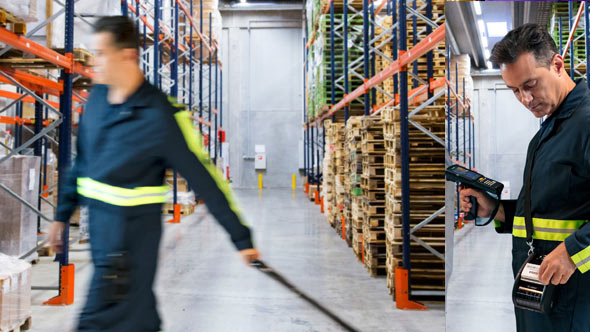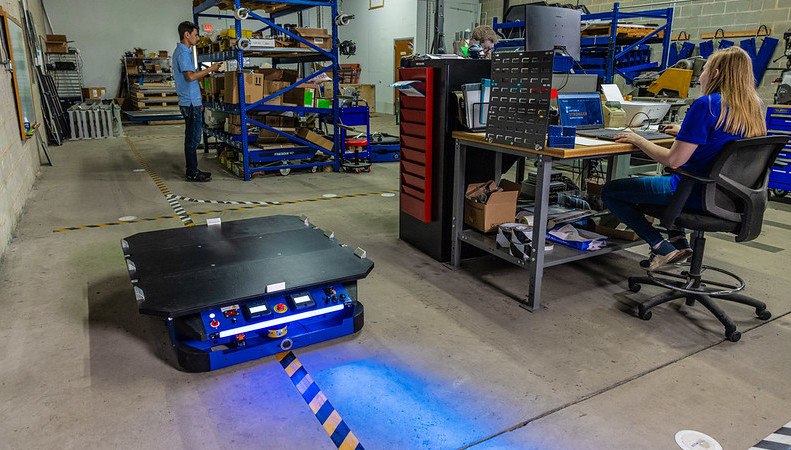E-commerce drives need for integrated technology
The warehouse is the nucleus of your business. It is the hub through which nearly everything must pass, from receiving to shipping. With e-commerce driving an expected 76% increase in the total volume of ordered items by 2020, staying competitive means filling orders faster and more accurately than ever. An integrated system of mobile, data capture and tracking technologies makes your warehouse future-ready.
The Impact of a Fragmented Warehouse
Technical fragmentation—the use of the right technology in only a few operations— constrains warehouse operations from keeping up with the pace of e-commerce. Warehouses feel the impacts of technical fragmentation at the operational, customer relations and financial levels.
Operational issues resulting from technical fragmentation:
- Inaccurate Information
- Reduced Productivity
- Increased Cost
- Reduced Customer Satisfaction
- Backlogged Order Fulfillment
- Lack of Visibility
Integration as a catalyst
To combat fragmentation and re-engineer operations for the faster pace of the e-commerce-driven economy, today’s forward-looking warehouse and logistics professionals are integrating mobile, data capture and tracking technologies throughout their operations. In addition to new levels of efficiency, accuracy and visibility, integration brings:
- Massively reduced paper processes
- Improved accuracy in item selection, packing and shipping
- More reliable tracking of materials and assets
Given the impact of e-commerce, employees need devices designed to enable greater order-fulfillment speed and accuracy.
6 Steps to a future-ready warehouse
The path to the future-ready warehouse begins by following six critical steps. Throughout the process, you integrate state-of-the-art warehouse technology for a more collaborative information architecture that not only enables a leaner, more flexible warehouse operation, but a leaner, more profitable enterprise. Equally important, your enhanced warehouse mobility can serve as the foundation for implementing more efficient enterprise-wide visibility.
- Equip workers with modern mobile technology
- Improve staff communication and management
- Get advanced inventory and storage capabilities
- Streamline order-picking processes
- Upgrade inbound handling operations
- Turn around outbound performance
Step 1: Equip workers with modern mobile technology
Greater efficiency starts with better front-line worker technology. To fill orders with greater speed and accuracy, your front-line workers need tools that facilitate efficiency and scanning precision, item-level picking and timely inventory visibility. Upgrading to modern enterprise mobile devices that combine scanning efficiency with touch-screen accuracy and ease of use enables them to validate data in real time and instantly locate the correct items. Also, front-line worker connectivity offers real-time access to the WMS so they can share information and offer end-to-end solutions quickly during peak times. By integrating modern mobile technology, real-time optimization of your fulfillment operation is possible.
Implications of equipping workers with outdated technology
Extensive training requirements
Workers are accustomed to using highly functional touch screens and user-friendly applications on their smartphones. But training them to use outdated mobile devices with green screens, multi-step processes and keystrokes can add weeks to training time—and during peak season, time is of the essence.
Limited inventory visibility
Paper-based systems or fragmented mobility utilization and reliance on “systems of record” might have been adequate for managing order fulfillment in the pre-e-commerce economy, but today the speed of fulfillment requires an inventory “system of reality”—and that means greater and more timely stock visibility.
Security compromises and disruptions
A lack of maximum enterprise-grade digital security and control on each device can cause warehouse operations to shut down, leading to a significant financial impact on the business.
Data double-touches
Before e-commerce disrupted retail—and, by extension, warehousing—many warehouses could manage activities from a desktop computer. In today’s higher-volume warehouse, though, this technology configuration reduces flexibility, slows down productivity and many times means manually re-entering data.
E-commerce order backlogs
By 2021, global e-commerce sales will surge to $4.5 trillion. Outdated or fragmented hardware can support slower manual workflows—not the faster, more streamlined workflows required for keeping up with higher e-commerce-driven volume that can cause order backlogs.
Sluggish order fulfillment
Older, outdated warehouse technologies running on legacy platforms don’t have the memory, processing speed or scanning capabilities that today’s intelligent, data-powered fulfillment requires.
Benefits of equipping workers with modern mobile technology
Modern touch-screen devices that enable fast data entry, scanning and worker training enable you to avoid common barriers to new device adoption. These devices enable you to seamlessly connect your front-line workers to the data they need to optimize your operation for today’s greater speed and accuracy demands.
- Decrease worker training time with an intuitive touch-screen interface and provide consistent support with on-screen instructions and single-button commands.
- Automate workflows to gain speed and efficiency by connecting each worker to enterprise systems.
- Increase productivity with faster processing power and applications that save seconds off every scan by capturing multiple barcodes, text, images and signatures in a single scan.
- Achieve real-time visibility by giving front-line workers a “system of reality” to work from that provides actionable insights for real-time decision making.
- Ensure security threats don’t make your business vulnerable to unexpected downtime with modern enterprise mobile devices that have extended support for operating systems.
- Get real-time data by empowering front-line workers to help manage warehouse activities and track goods and assets right from the warehouse aisles, receiving and shipping docks.

Step 2: Improve staff communication and management
Enabling seamless collaboration is essential to the future-ready warehouse. This requires fast and efficient task management enabled by real-time voice and data communications between supervisors and employees everywhere in the facility. Managers can proactively direct work orders and assign tasks that are not currently driven by the WMS, as well as monitor the efficiency and progress of work as it is being performed. Also, better communication and real-time information beyond the four walls enhances collaboration with partners and vendors, which improves the warehouse’s omnichannel fulfillment capabilities.
Implications of ineffective staff communications
Slow problem-solving
Without the option of mobile connectivity, warehouse managers may be "chained" to their desktop computers, preventing them from spotting and resolving issues on the warehouse floor in real time.
Slower operations
Without high-speed mobile voice and data access, procedures such as automation, cross-docking and task interleaving are not feasible.
High employee turnover
When warehouse managers are inaccessible to workers on the floor to offer support and resolve issues, job satisfaction drops and employee turnover rates increase.
Inefficient workflows
Using an inefficient pager system for manager-to-employee-to-shipper communications can create delays in interactions — a barrier to work efficiency.
Delayed reactions
Too often, workers cannot communicate effectively with each other, supervisors, or managers in real time, making immediate issue resolution and higher productivity all but impossible.
Mobile communications solutions
Benefits of mobile voice and data communications solutions
- Empower managers to get out of the office and onto the floor, maximizing on-the-job efficiency and effectiveness.
- Give managers access to all business systems and workers with the push of a button.
- Eliminate lost time walking to a phone station with each employee able to communicate right from their own device on the warehouse floor.
- Eliminate distracting, nearly unintelligible overhead pages.
- Introduce security measures by providing electronic employee access, identification and locationing via physical ID badges with embedded RFID.
Step 3: Get advanced inventory and storage capabilities
In the future-ready warehouse, properly stocked inventory is a requirement. Traditionally, cycle counts conducted manually or with older or fragmented technology have been fraught with errors and are time-consuming. But the perception of cycle-counting value is changing: In the Zebra® Warehousing 2020 Vision Study, respondents reported that the top two cycle-count motivating factors are reduction of out-of-stock conditions and ensuring WMS accuracy. Accurate barcode or RFID tag data capture makes these outcomes possible—it’s a question of choosing the right form factor for the workflow, such as a mobile computer with a built-in, state-of-the-art barcode scanner or RFID reader. It's interesting to note that, in another Zebra® survey on fulfillment, 91% of respondents said they plan to implement RFID-based inventory management systems by 20282. Enterprise-wide adoption of such advanced tools provides front-line workers with inventory visibility throughout the supply chain.
Implications of keeping manual or low-tech cycle counting
Inventory inaccuracies
Manual cycle counting is costly, time-consuming and error-prone — and a major reason for a lack of accurate, timely inventory availability and control.
Out-of-date reconciliation
Manual or low-tech cycle counts may take days or weeks, during which thousands of picks or putaways may occur, creating more inaccuracies.
Elevated regulatory risk
To meet increasingly stringent regulations, companies must keep accurate inventories. No company wants the major disruption of a shutdown to do a complete physical inventory.
Out-of-balance sheets
A lack of real-time visibility into inventory and storage affects inventory valuation, adversely impacting your company’s balance sheet.
Cycle-counting and asset-tracking solutions
Benefits of real-time inventory data collection and analysis
- Reduce full inventory and cycle counting time to dramatically improve efficiency
and accuracy—cycle counts can be reduced from three to four weeks to just a
day and a half.
- Schedule more regular and routine cycle counts to ensure accuracy.
- Improve ordering processes with better real-time trend data.
- Reduce out-of-stock conditions with reliable WMS data.
- Decrease capital expenditures for over-stocked inventory.
- Utilize warehouse space more efficiently with right-sized inventory.
Benefits of automated asset tracking using RFID
- Reduce downtime by knowing the exact location and condition of assets in
the warehouse.
- Optimize processes and improve planning and efficiencies by utilizing analytics
from real-time and historical asset usage.
- Improve return on investment (ROI) and reduce the total cost of ownership (TCO)
by extending the life of your assets.
Step 4: Streamline order-picking processes
Updating picking processes has become a major concern for many warehouses. In Zebra Technologies’ recent warehouse survey, almost 60% of respondents indicated plans to increase automated processes and 76% plan to equip staff with more technology by 2020. These initiatives are especially valuable in these functions because costs are high and errors can easily yield many dissatisfied customers. A future-ready warehouse is likely to use wearable mobile computers or scanners to dramatically increase the efficiency of the specialized workflows within this process.
Implications of out-of-date picking processes
Inefficient product locating
With legacy pick-and-fill processes, workers can spend up to 70% of their time walking to locate the right product, wasting time and reducing productivity.
One-at-a-time order processing
The linear nature of manual order picking means workers must process one item at a time, resulting in costly, ineffective and inaccurate inventory visibility and higher carrying costs.
Unknown errors
With manual processes and fragmented solutions, products cannot be automatically verified when picked, leading to unrecognized errors and inaccurate staging, packing and shipping.
Costly disappointments
Inefficient picking and filling operations cause inventory inaccuracies that all too often lead to costly out-of-stocks, lost orders, disappointed customers and lost revenues.
Inefficient labor utilization
The rising volume of orders flowing through the warehouse, especially orders of smaller size and lesser value, causes the relative labor expense for filling each order to rise, reducing already thin margins.
Pick-and-fill solutions
Benefits of mobility for picking operations
- Increase number of orders processed and reduce errors to lower cost per order.
- Eliminate lost time navigating to empty or wrong bin locations with real-time on-hand
inventory quantity and exact location.
- Get faster pick times and safer workflows with hands-free, multi-modal picking solutions.
- Help downstream operations verify orders by ensuring damaged or missing barcodes
are replaced at the point of picking.
Benefits of real-time order and inventory data
- Conserve time with automatic pick list along with the fastest route to each item.
- Enhance existing pick schemes such as pick-to-tote, pick-to-light and carousels.
- Receive instant verification that the right item has been picked.
- Eliminate out-of-stocks by instantly deducting items from inventory as they are picked.
- Receive granular picking information that enables LIFO/FIFO for improved inventory
management.
- Instantly store serialized product information with customer orders to allow fast
location of recalled products.
Step 4: Streamline order-picking processes
Receiving and sortation are critical steps in fulfillment operations. Issues in receiving all too often morph into other issues throughout the warehouse. A future-ready warehouse uses barcode scanning and RFID to operationalize and streamline inbound processes. The Zebra Technologies warehousing survey found that warehouse executives plan to expand the use of barcode scanning by 67% by 2020. Increasingly, a future-ready warehouse also includes technology that accommodates RFID, integrated advanced shipping notices and global data-sharing standards. Sound receiving processes are the origin of goods visibility throughout the entire supply chain.
Implications of using outdated receiving and sorting technology
Paper-driven inefficiency
Using paper-based systems or fragmented manual technology results in lost time, reduced order accuracy, decreased productivity and a lower return on investment.
Slow dock-to-stock
Delays caused by paper-based processes and fragmented technological solutions
reduce inventory control and lead to false out-of-stocks and lost sales.
Inventory on idle
Product sitting on a dock or misplaced in inventory is more than simply idle, it’s also unavailable, which can mean lost sales and dissatisfied customers.
Equipment misuse
Poor visibility and inefficient management of material handling equipment (MHE) like forklifts
and crawlers reduces MHE availability and productivity, and increases maintenance costs.
Poor visibility
Slow and inaccurate receiving and put-away are barriers to timely inventory visibility and
control, as well as to effective cross-docking, task interleaving, traceability and tracking processes.
Clogged aisles
Slow, inaccurate manual processes and the limited throughput of older technology can cause congestion in your aisles, wasting time and decreasing productivity.
False out-of-stocks
Put-away errors and delays can create inventory inaccuracies, which can result in erroneous out-of-stock situations, unnecessary product replacement costs and lost sales.
Many unhappy returns
Inefficient reverse logistics processes result in slow return of product to inventory, delayed customer credit processing and decreased customer satisfaction. Increasing returns volume in the e-commerce age intensifies these process problems.
Receiving and sortation solutions
Benefits of mobility at the receiving dock
- Process more inbound shipments with increased accuracy and productivity.
- Identify incoming shipments in real time automatically by reading emitted data
from an RFID tag or with a simple barcode scan of a shipping label or return
merchandise authorization (RMA label).
- Quickly validate and update returns and issue customer credit automatically.
- Identify shipment errors by electronically receiving goods against system
purchase orders.
- Prioritize put-away of low-stock or out-of-stock items with more timely
inventory visibility.
- Reduce handling time and costs of cross-docking operations with improved
efficiency of forklift driver assignments.
- Ensure efficient put-away and picking by replacing missing or damaged
barcode labels with mobile printing on the receiving dock.
Benefits of real-time WMS access
- Verify location matches WMS with a barcode scan of item and shelf tag.
- Ensure all cartons and pallets are accounted for and put away together by
accessing WMS for exact location of all inventory.
- Reduce waste by ensuring proper stock rotation for either FIFO or LIFO
inventory management.
- Quickly respond to changes in inventory, production status and customer
requests with automated lean replenishment processes.
Step 6: Turn around outbound performance
Efficient packing, staging, loading and shipping lead to timely deliveries. To serve today’s more demanding marketplace effectively, the future-ready warehouse enables front-line workers with reliable item-tracking technologies such as barcode or RFID technologies and mobile data capture devices to complete these processes efficiently. These important functions are critical to setting the stage for order verification, real-time visibility and dependable tracking while goods are in transit to the customer—resulting in streamlined delivery, enhanced competitive advantage and increased customer satisfaction and loyalty.
Implications of manual outbound processes for packing, staging, loading and shipping
Sluggish turnaround
Manual order verification in the final stages of fulfillment can lengthen turnaround times, causing significant shipping delays and carrier detention charges.
Packing inefficiency
In packing operations, the lack of complete order information can easily result in orders that are incomplete, inaccurate and packed in the wrong size cartons or containers.
Change resistance
Often, manual processes can’t accommodate last-minute order modifications and emergency orders.
Customer dissatisfaction
Manual data processing and paperwork can cause delays and errors in manifest creation and shipping labels that ultimately can lead to customer dissatisfaction.
Packing, staging, loading and shipping solutions
Benefits of real-time data for outbound operations
- Ensure greater order accuracy with a final electronic verification and on-the-spot printing of necessary labels or paperwork.
- Notify packers in real time of arrival of back ordered items to include in shipment prior to shipping.
- Control packing material costs by accessing item’s dimensional data with mobile computers to select the right size carton.
- Reduce mis-ships by scanning items while loading to verify the right carton or pallet is on the right truck.
- Reduce driver dwell time with real-time visibility of staged goods for fast and accurate loading.
- Maximize customer satisfaction and retention with on-time and accurate orders.
Zebra®: The data foundation of the future-ready warehouse
Our complete array of rugged enterprise mobile devices improves warehouse communications and mobile data capture in the warehouse, delivering visibility of goods, assets and people—not just inside the four walls but also across the entire supply chain.






